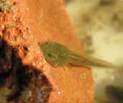Basic HTML Version


Pond restoration:
get the wellies...
Autumn is the time of year best suited to
pond clearance, since many of the plants
and animals are dying back and frogs are
not yet returning to ponds to lie dormant
through winter.
Bucket out the water, or use a pump if you
have one, until there is only a small layer of
water on the bottom, along with the pond
silt. Carefully remove the uppermost layer
of silt and put this in a bucket. This layer is
where most invertebrate eggs and larvae
are lying dormant, so this will need to go
back into the pond once re-filled.
Put all pond plants into buckets while
doing the work. Excess plant matter can
be composted. You might also come
across amphibians (particularly frogs in
late autumn). If so, carefully place them in
a bucket (remember air-holes) with lots of
damp vegetation and release them back into
a covered area (e.g. under a bush, a log-pile)
next to the pond as soon as the work is
finished.
Refilling the pond with tap-water is
generally fine, though sensitive animals (e.g.
overwintering dragonfly larvae) may need to
be kept out of the pond until the water has
been treated (see water worries page 10).
l o o k i n g a f t e r y o u r
w i l d l i f e p o n d
p
o
n
d
v
i
s
i
t
o
r
s
Tadpole
(common frog)
If you regularly
remove dead leaves and
vegetation from your pond then
you might only need to clean out
your pond once every five or ten
years. However, most ponds will
need some clearance at least
every three or so years.
(Photo: wellies/Emma Scott)

